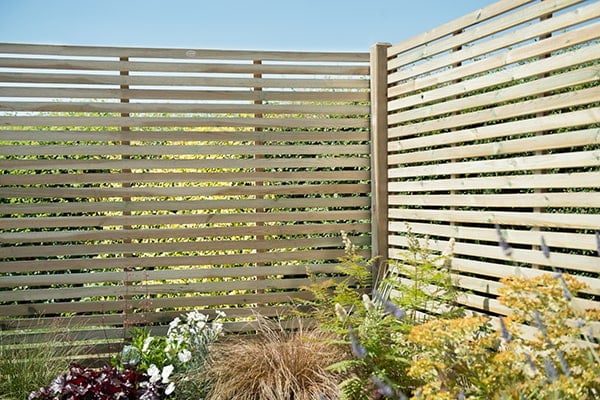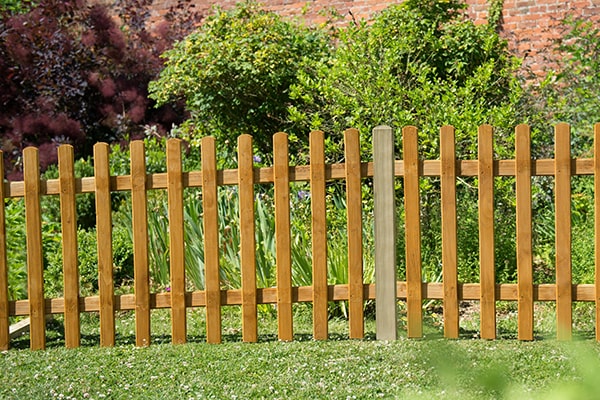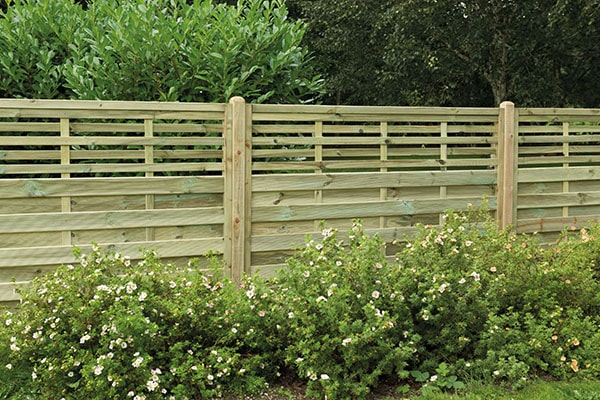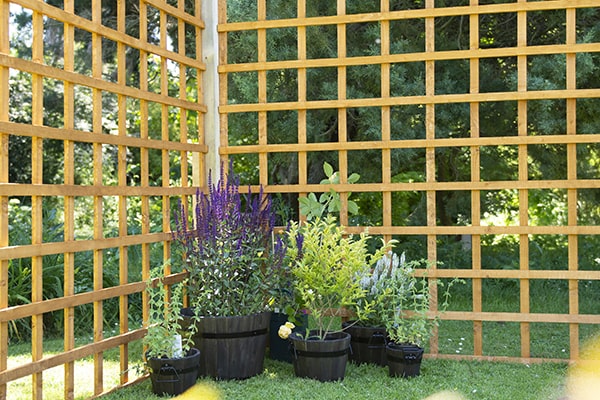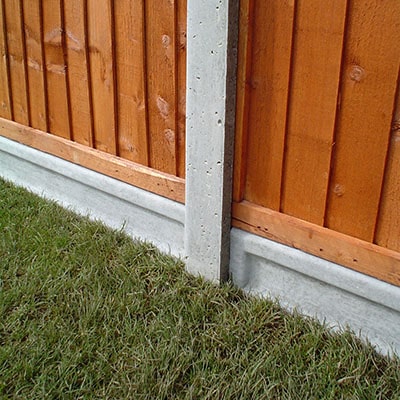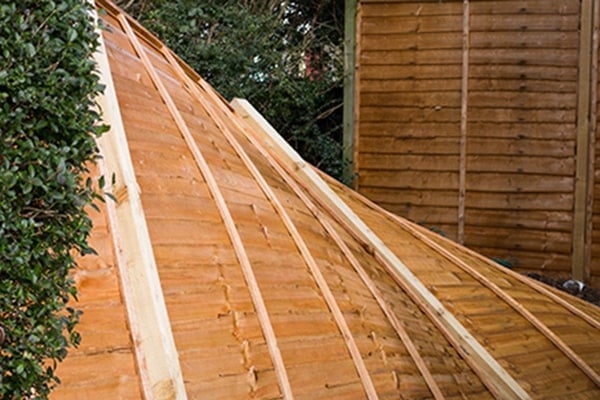
Wind is a guaranteed feature of British weather, so you will need windproof fence panels to contend with it. Though wind may be good for blowing the cobwebs away on a blustery walk, it is not so good for the garden. Fences, in particular, take a battering during windy weather.
For those of us living in windier areas such as the North, South West, high-altitude or other exposed areas, choosing the best fence for windy areas is an important decision.
Not only is this financially astute, but it prevents the unappealing sight of bowed, leaning fencing ruining your garden design. Read on as we discuss the art of wind resistant fence design and the best fence panels to choose for windy areas.
Editor’s Note [26.03.2024]:
Our article about the best fence panels to choose for windy areas was originally published on March 29, 2018. Today we have added a major upgrade with content revisions throughout. New sections have been added about understanding windproof fence panels, identifying wind-prone areas, choosing the right fencing for windy areas, understanding the dynamics of wind resistant fence design, installation tips for windy areas (including preparation and secure fixing techniques), the importance of fence posts, and also related articles to windproof fencing.
Choosing the right fencing for windy areas
Let us chat about windy conditions, the invisible troublemakers for garden fences. This is not just about a few leaves getting tossed around; we are talking about the kind of gusts that can destroy garden fencing over a period. It is important to buy windproof fencing in high wind areas and we discuss this below.
Identifying wind-prone areas
So, how do you know if your garden is particularly prone to wind and you may need fencing for windy areas? Well, there are a few tell-tale signs:
- Flower forecast - if your flowers and plants often look like they have been battered, the wind is most probably the culprit
- Garden debris - finding more twigs and branches in your garden than usual? That is the wind dropping them off
- Listen to the leaves – do you have an orchestra of rustling leaves often? That is the wind tuning up your garden
- Location check - if your place is out in the open, like on a hill or near the coast, then yes, expect some windy visits
- Neighbourhood watch – do you see any fences around looking a bit wonky or patchy? That could be the wind creating damage in your area
- Tree Talk - look at the trees around your garden. If they are leaning like they are trying to escape, that is Mother Nature giving you a hint
- Weather reports - keep an eye on local weather reports; if high winds are a regular feature, your garden is probably a hotspot
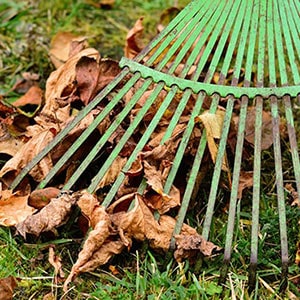

Understanding windproof fence panels
When the wind starts, it does not forgive, especially with fences. We are looking at strong winds that can turn a sturdy fence into something that looks like it has been in a tussle with a giant. Different types of fences react differently. But are 100% windproof fence panels available?
A solid panel fence tries to stand its ground, but it is like holding a shield against a gale; sometimes, the wind wins.
Then there is the slatted or hit & miss styles, which let the breeze flow through like it is nothing. We discuss fence panel types below; it is important to understand the strengths and weaknesses of your fence style when the wind decides to arrive with force.
Understanding the dynamics of wind resistant fence design
Now, let us talk about fencing design because it is not just about looking good. The way your fence is built can seriously impact how it manages a windy day.
First off, think about 'give'. Solid panels are like trying to hold back the wind with a flat hand and not perhaps the most effective. They catch the wind like a sail, which can lead to a garden remake you did not sign up for. On the other hand, designs with gaps, like slatted or lattice panels, let the wind reduce pressure.
Another tip is opting for shorter panels. They might not give you a castle-wall feel and the privacy you desire, but they are less likely to turn into wind catchers. Also, consider the thickness of the material. Chunky can be good, but too thick might just make your fence too stubborn to sway with the wind. It is all about finding that sweet spot where your fence is sturdy enough to stand its ground, but also knows when to go with the flow.
When choosing a fence for a windy spot, think of it like picking a dance partner for a wild night out. You want something that can move with the rhythm, not something that will topple over at the first gust. Design dynamics involve clever design, smart materials, and flexibility and are part of a good-quality fence.
Installation tips for windy areas
When you are dealing with windy conditions, installing a fence is not just about digging holes and popping in posts. It is more like prepping your garden for a bit of a tussle with Mother Nature.
Preparing the ground
Ground preparation is like the unsung hero of fence installation, especially in windy spots:
- Check the lay of the land - you want a level and stable area to work with. If it is uneven, take the time to level it out; it is worth the effort.
- Drainage - next, think about drainage because waterlogged soil is a fence's nightmare. Good drainage keeps your posts' feet dry and less likely to rot
- Consider the soil type – sandy or loose soil might need extra work, like a deeper foundation, to keep those posts standing tall. Remember, good ground preparation is half the battle won in keeping your fence upright when the wind is active
Secure fixing techniques
Let us discuss how to make sure your fence stands its ground, even when the wind is having a bit of a moment. How to brace a fence against wind about being smart and sturdy with your installation.
- Attaching the panels – once the concrete is set, it is time to attach the panels to the posts. Use heavy-duty screws for a secure fit
- Bracing for success – while the concrete is setting, brace your posts to keep them straight. Think of it as giving your posts a bit of moral support
- Choosing the right posts – start with selecting robust posts, like the heavy-duty kind, because they are going to be the main support act for your fence (see our later section on this topic)
- Concrete is a friend – mix and pour concrete into the holes. This step is like setting the stage for your posts, giving them a rock-solid base
- Digging deep – dig those post holes deep and wide, around a third of the post's height deep. This depth gives your posts a solid anchor
- Double-checking – give everything a once-over, and make sure it is all tight and right. You are aiming for sturdy, not shoddy
- Post positioning – pop your posts into the holes and use a level to make sure they are straight
Robust & Solid Best Fence Panels
Where privacy and security are a priority, a solid fence is a must. However, a fence panel that is solid in nature will take the brunt of a windy spell. Therefore, is important that the construction is heavy-duty enough to withstand this battering.
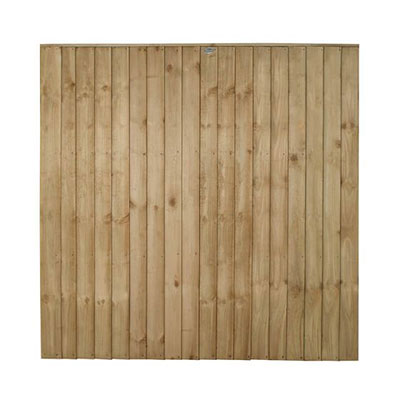

Closeboard Fence Panels
A closeboard fence panel is made of vertical boards with two to three horizontal supports. The greatest benefit of a closeboard fence is that it is fully framed. This stops the boards from being forced apart by bad winds.
Fence Panels with Gaps
Instead of trying to completely block the wind, slatted fence panels dissipate powerful gusts. With wind allowed to pass through the gaps, the fence is not forced to create resistance. To buy entirely windproof fence panels is a challenge, but garden fence panels with gaps work well.
Slatted Fencing
As well as allowing wind to harmlessly pass through, slatted fencing is also considered one of the most contemporary options. Its sleek lines, available as slatted or double-slatted, are ideal for complementing a modern garden.
Picket Fencing
Though less private than slatted fence panels, picket fence panels also work brilliantly in windy conditions. Also known as palisade fence panels, the very nature of their design reduces the wind’s power thanks to the gaps between the vertical boards. Furthermore, a rustic traditional picket fence will complement a country garden beautifully.
Hit and Miss Fencing
Often wave or domed topped, or topped with trellis, hit and miss fence panels are part of the decorative fence panels collection. The hit and miss construction, where the boards are alternatively positioned behind or in front of the supports, creates natural gaps in the fencing. These gaps allow some of the wind to pass through, weakening the impact on the fence panel.
Trellis Panels
If privacy isn’t an issue for you, trellis panels are perfect in windy areas if they are properly secured. Adorned with climbing plants, they can also provide some coverage.
Windproof Fence Panels Installation in Windy Areas
Fence installation should always be carefully completed but it is even more vital when fencing in a windy area. No matter how strong the fence is, it won't overcome poor installation.
Are fence posts important in a fence in windy areas?
Absolutely, yes! The main emphasis on this article is fence panels, but fence posts play an especially crucial role. Without strong fence posts any fencing run, would not be able to withstand strong winds.
Read the points below to understand the important role that fence posts play:
- Anchor of strength - like an anchor keeps a ship in place, the fence posts keep the fencing in place. They are the equivalent of the roots of a tree and are an anchor of strength
- Depth and installation - fence posts need sufficient depth to be anchored, the one third rule applies, e.g. 2 feet under ground and 6 feet above ground. Fence posts are relatively straightforward to install but we recommend you use concrete gravel boards to anchor your fence posts
- Material matters - the material plays an important role in fence post strength. Using the best materials is important. We recommend concrete, or treated wood, these materials withstand wind pressure and are more effective than weaker materials
- Spacing is vital - Closer spacing reduces the risk of wind and storm damage. Consider the spacing between your fence posts carefully, as this will impact your wooden fence panels
Concrete Fence Posts
As concrete fence posts are heavier than wooden ones, they are perfect for windy conditions. After setting them at least two feet deep, use postcrete to keep them in place. Posts made of concrete will not move for many years. Combine them with the panels above for the ultimate wind defence system.
If you’re looking for all our fence panels or trellis panels, browse through Buy Fencing Direct’s entire range here.
Related articles
The following related articles from our blog on fencing weather preparation are also recommended for reading:
Conclusion - ensuring fence durability with windproof fencing
So, we now conclude our article about fences for windy gardens. Lots of topics have been covered including how wind impacts fences so you can make the right fencing buying choices. When buying fences in windy spots, choosing wind resistant designs and materials is your best approach. Slatted and hit & miss styles let wind pass through without causing damage. Your fence panels need to be backed with correctly installed solid fence posts.
As we said, fencing designs are important. You need security, but you also want fencing, which blends in with your chosen decor. If you happen to have a garden in a wind hotspot, choose designs with "a little give" avoid solid designs, which will fight with the wind. This way your fencing will be standing tall and looking good for many years to come.
Contact us about the best fence for windy areas
Contact us today to discuss windproof fence panels. The Buy Fencing Direct team has a wealth of experience and has assisted many customers in buying the best fence for windy areas both before and after many past storms.
Buy fence panels, which are built to last and are available in a diversity of sizes and styles. We can provide all the advice you need about how to brace a fence against wind and protecting fencing from storm damage. Why not read our blog article about how to repair or replace fencing, as well as speak to us about fencing supplies and accessories.
Contact us in any of these ways:
- Call us at - 0333 003 0515
- E-mails – send through our contact form
- Text chat - our live chat app enables real-time text chat with our team





